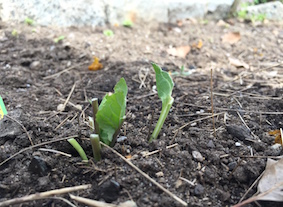Protecting Vegetable Gardens from Rabbits
Views: 4665

You don’t expect to see much wildlife when you move to a city. At least I didn’t. There are the rodents, of course, but let’s not talk about them. When I lived in a more densely population section of Boston I was surprised at the number of raccoons I saw. Moving just 1.5 miles away, the neighborhood is somewhat less densely populated, but also has more green spaces—empty lots with trees, brush and rocky outcrops, mostly. These are perfect spots for wildlife to hang out. We not only have raccoons but also skunks, rabbits and even several families of turkeys. One night I opened my front, sidewalk-facing door to find an opossum perched atop my tough plastic compost bin. Those eyes—good grief! I have not as of yet seen a deer, so I have no right to complain.
This year our Cedar Street community garden has a rabbit problem. Remember, I’m not complaining. Instead I’m throwing my hands up in the air like Groundskeeper Willie and shouting, “Arrrgh!”
Whew. Well, that was cathartic. Now let’s get down to solving the rabbit problem.
After doing a little research, there are three ways to protect your garden from rabbits.
Fencing. If your vegetable garden is suitable and you’re up for it yourself, consider putting fencing around the entire garden. Consider using wire fencing, something that rabbits can’t chew through. Depending on the garden’s size, you could use sturdy chicken wire or something more suitable for bigger areas. And of course, the holes in the fencing should be an inch wide or less.
Some rabbits can burrow under fencing, so do be sure to dig the fencing at least 1 ft. into the ground. The aboveground portion should be at least 2 ft. high. The top portion of the fencing should angle outward at about a 45-degree angle to prevent the rabbits from hopping over. My community garden is protected by 4 ft.-tall hurricane fencing, however, I spotted the rabbit in question leaving the garden through a hole! Check your fencing!
Repellents. Repellents are iffy, at best, and nothing is guaranteed to work. With that in mind, there are several commercial products and DIY-type formulations that repel rabbits. Many of the commercial products include blood meal and bone meal (which are also great sources of nitrogen and phosphorus). Using human hair can work, too. They say these products cause fear in the rabbit. Sticking with odor as a repellent, you might also experiment with strong natural smells (plants like marigolds, pointed-leafed basils and other strong herbs) and un-natural smells (fabric softener sheets and such).
Protection. Really what we need to do is protect the young plants from the rabbits until they’ve ground large enough to “make it on their own,” i.e. they can take some nibbling but still have enough of themselves to keep growing. Also, when plants grow on, they are not as tender—and not as delectable—as younger plants. What you might want to do is cover the young plants with a light fabric row cover. Have it loose enough to leave room for the growing plants but also be sure to secure it into the ground so rabbits can’t sneak underneath.
Which option will I choose? Well, I wish I had Groundskeeper Willie on my side.
Meet Ellen Wells
When you’re raised on a farm, you can’t help but know a thing or two about gardening. Ellen Wells is our expert on edible gardening.…
Ellen's Recent Posts

Asparagus






